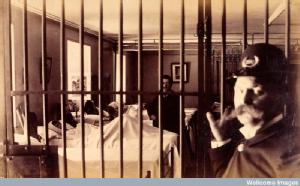Psychiatry and the 'Manufacture of Madness'
TOPIC 8 (WEEK 10): INTRODUCTIONThis week we will explore the ways in which the psychiatric profession consolidated itself in the 19th century. Particular attention will be paid to the role of psychiatrists in the asylum, in evolving diagnostic and treatment regimes, their changing status and role as expert witnesses in the courtroom, which brought them increasingly to the attention of the public and gave them opportunities to display knowledge and competency in dealing with the mentally ill. This story of consolidation is far from straightforward and was influenced strongly by the efforts of doctors to establish themselves, while working in an environment which was highly stigmatised. We will also explore two chapters in Masters of Bedlam (Conolly and Maudsley), which provides excellent overviews of individual psychiatrists and their careers, and bookmarks the shift from optimism to pessimism in asylum practice.
The history of prison medicine and psychiatry and criminal insanity is emerging as a robust subject area and I will direct you to readings on this theme, and see for what I get up to when I'm not teaching our website histprisonhealth, which includes blogs on responses to mental illness in prison.
|
 |
QUESTIONS
- How did psychiatry consolidate itself as a specialist field of practice in the 19th century?
- Did asylums become ‘museums of madness’ curated by doctors in the 19th century?
- Why and in what ways was the insanity plea employed in the 19th century?
- Did forensic psychiatry bolster the reputation of the psychiatric profession?
- How did criminal lunatic asylums and prisons become new sites of the practice of psychiatry in the 19th century?
READING
** Andrew Scull, Charlotte Mackenzie and Nicholas Hervey, Masters of Bedlam: The Transformation of the Mad-Doctoring Trade (Princeton University Press, 1996). (This has very useful biographies of individual psychiatrists and asylum keepers). e-book and multiple copies in library
** Shorter, A History of Psychiatry, esp. chs 1-2. e-book
** Akihito Suzuki, ‘Framing Psychiatric Subjectivity: Doctor, Patient and Record-Keeping at Bethlem in the Nineteenth Century’, in Insanity, Institutions and Society, pp. 115-36. e-book
** Laurence J. Ray, ‘Models of Madness in Victorian Asylum Practice’, Archives of European Sociology, 22 (1981), 229-64. e-journal
** Andrew Scull, Museums of Madness: The Social Organization of Insanity in 19thCentury England (London: Allen Lane, 1979).
** Andrew Scull, The Most Solitary of All Afflictions: Madness and Society in Britain, 1700-1900 (Yale University Press, 1993), ch. 5. Multiple copies in library
* Andrew Scull, Social Order/Mental Disorder: Anglo-American Psychiatry in Historical Perspective (London: Routledge, 1989). (Useful essays on doctors in psychiatry). e-book
CRIMINAL INSANITY and PSYCHIATRY IN PRISON
|
** Stephen Watson, 'Malingerers, the ‘Weakminded’ Criminal and the ‘Moral Imbecile’: How the English Prison Medical Officer became an Expert in Mental Deficiency, 1880–1930', in Michael Clark and Catherine Crawford (eds), Legal Medicine in History (Cambridge University Press, 2004), 223-42. e-book
** Jade Shepherd, ‘“I am very glad and cheered when I hear the flute”: The Treatment of Criminal Lunatics in Late Victorian Broadmoor’, Medical History, 60 (2016), 473-91. e-journal
* Patricia H. Allderidge, ‘Criminal Insanity: Bethlem to Broadmoor’, Proceedings of the Royal Society of Medicine, 67 (1974), 897-904. e-journal
* Joseph Melling, Bill Forsythe and Richard Adair, ‘Families, Communities and the Legal Regulation of Lunacy in Victorian England: Assessments of Crime, Violence and Welfare in Admissions to the Devon Asylum, 1845-1914’, in Outside the Walls of the Asylum, pp. 153-80. e-book and several copies in library
Pauline M. Prior, ‘Mad, Not Bad: Crime, Mental Disorder and Gender in Nineteenth-Century Ireland’, History of Psychiatry, 8 (1997), 501-6. e-journal |
Pauline M. Prior, ‘Prisoner or Patient? The Official Debate on the Criminal Lunatic in Nineteenth-Century Ireland’, History of Psychiatry, 15 (2004), 177-92. e-journal
Oonagh Walsh, ‘Lunatic and Criminal Alliances in Nineteenth-Century Ireland’, in Outside the Walls of the Asylum, pp. 132-52. e-book and several copies in library
Catherine Cox, Negotiating Insanity in the Southeast of Ireland, 1820-1900 (Manchester: Manchester University Press, 2012), ch. 3. e-book
Mark Finnane, Insanity and the Insane in Post-Famine Ireland (London: Croom Helm, 1981), ch. 3. e-book
* Stephen Garton, 'Criminal Propensities: Psychiatry, Classification and Imprisonment in New York State 1916-1940, Social History of Medicine, 23 (2010), 79-97. e-journal
* Catherine Cox and Hilary Marland, 'Broken Minds and Beaten Bodies: Cultures of Harm and the Management of Mental Illness in Late Nineteenth Century English and Irish Prisons’, Social History of Medicine, 31 (2018), 688-710. e-journal
* Catherine Cox and Hilary Marland, ‘“He must die or go mad in this place”: Prisoners, Insanity and the Pentonville Model Prison Experiment, 1842-1852’, Bulletin of the History of Medicine, 92 (2018), 78-109. e-journal
Janet Saunders, ‘Magistrates and Madmen: Segregating the Criminally Insane in Late-Nineteenth-Century Warwickshire’, in Victor Bailey (ed.), Policing and Punishment in Nineteenth Century Britain (London: Croom Helm, 1981), 217-41.
Henry R. Rollin, ‘Forensic Psychiatry in England: A Retrospective’, in 150 Years of British Psychiatry II, pp. 243-67.

